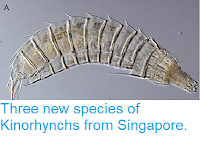The first Worm-burrows appear in the Late Ediacaran Period, about 560 million years ago. These burrows are two-dimensional in form, apparently made by creatures that burrowed a few millimetres beneath the surface but did not venture deeper into the sediment. The onset of the Cambrian is marked by a dramatic increase in burrowing activity, with burrows dug three-dimensionally into the substrate, and the bioturbated sediments, previously unknown, becoming widespread in the rock record. However, while these burrows have been widely used as a way of dating the beginning of the Cambrian, the identity of the burrow makers has remained unclear, though many palaeontologists have speculated that it might be a Priapulid-like Scalidophoran Worm. The Scalidophora is the wider group comprised of Priapulids, Kinorinches and Loriciferans, phyla united by a chitinous cuticle which is periodically moulted and denticle-covered
pharynxes which can be everted to form proboscises; the Scalidophorans along with the Panrthropods (Arthropods, Tardigrades and Velvet Worms), the Nematodes and the Nematomorphs (Horsehair Worms) make up the Ecdysozoa. Numerous Scalidophoran Worms are known from the Burgess Shale and other similar Cambrian Lagerstätten, but these deposits do not record the Earliest Cambrian, where their presence has been inferred from sclerites (fragments of exoskeleton) which appear to be of Scalidophoran origin.
In a paper published in the journal Proceedings of the Royal Society Series B: Biological Sciences on 16 January 2019, Giannis Kesidis and Ben Slater of the Department of Earth Sciences (Palaeobiology) at Uppsala University, Sören Jensen of the Área de Paleontologıá at the Universidad de Extremadura, and Graham Budd, also of the Department of Earth Sciences (Palaeobiology) at Uppsala University, describe a series of exceptionally preserved trace and body fossils from sandstones of the Early Cambrian File Haidar Formation of southern Sweden that can unequivocally be assigned to a Scalidophoran producer.
Kesidis et al. report a series of fossils in positive semirelief on the base of a sandstone bed within the Mickwitzia Sandstone Member of the File Haidar Formation. These are associated with burrow systems, but show details of the structure of the surface of an animal of clear Scalidophoran affinities, which appear to be casts of the actual animals. These have bulbous protrusions with longitudinal striations, which appear remarkably similar to modern Priapulids.
In order to try to understand the formation of these fossils, Kesidis et al. tried experimentally placing specimens of the modern Priapulid Priapulus caudatus, which appears similar in size and morphology to the specimens, in tanks where mud has been allowed to settle and then topped off with a layer of fine sand (this is unlike the typical environment of Priapulus caudatus, a species which typically dwells in soupy mud where any tunnels will collapse behind it as it moves). The activities of the Worms drew the sand into the burrows, and prising the burrows apart showed striated marks left by the sclerites of the Worms, which appeared similar to the striations in the Mickwitzia Sandstone burrows. Subsequent filling of some burrows with Plaster of Paris produced structures almost identical to the Cambrian material.
See also...
(a) Close-up of specimen detailing lateral bulbous protrusions (aborted probes). (b), (c) Anterior details of bulb-like terminations in specimen, illustrating 20 radiating longitudinal striations. Note that striations bifurcate distally, indicating rotation of the worm’s prosoma during excavation. (d ) Schematic of morphology observed in (b), (c). Scale bars: 5 mm (a) 2 mm (b), (c). Kesidis et al. (2019).
In order to try to understand the formation of these fossils, Kesidis et al. tried experimentally placing specimens of the modern Priapulid Priapulus caudatus, which appears similar in size and morphology to the specimens, in tanks where mud has been allowed to settle and then topped off with a layer of fine sand (this is unlike the typical environment of Priapulus caudatus, a species which typically dwells in soupy mud where any tunnels will collapse behind it as it moves). The activities of the Worms drew the sand into the burrows, and prising the burrows apart showed striated marks left by the sclerites of the Worms, which appeared similar to the striations in the Mickwitzia Sandstone burrows. Subsequent filling of some burrows with Plaster of Paris produced structures almost identical to the Cambrian material.
(a) Specimen A, discrete cylindrical structure interpreted as a mouldic Priapulid body fossil. (b) Specimen B, elongated burrow, with bulb-shaped aborted probes emanating from the main burrow. (c), (d) Plaster of Paris casts of extant Priapulus caudatus burrows exhibiting strikingly similar wall ornamentation to that of Specimens A and B. Scale bars: 5 mm (a), (b), 10 mm (c), 8 mm (d ). Kesidis et al. (2019).
See also...
Follow Sciency Thoughts on Facebook.






